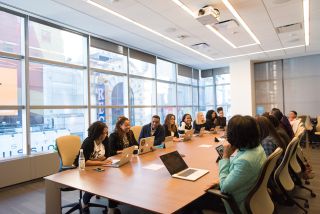Career
Psychology-Approved Design Strategies for Return-to-Work
Workplace design should provide control and empowerment for employees.
Posted March 21, 2023 Reviewed by Ekua Hagan
Key points
- The design of the workplace plays an important role in encouraging return-to-work.
- Design strategies for return-to-work must go hand-in-hand with meaningful organizational strategies.
- Employers can create a favorable psychosocial environment by empowering employee control over decisions.

As individuals report a greater loss of control and decreased trust in institutions during COVID-19, employers are left wondering how to facilitate a successful return to the office. Supported by thoughtful organizational policies, the design of the workplace itself may play an important role in encouraging return-to-work. Employees’ perceptions of return-to-work can be improved by mechanical control (think: workspace design) and empowerment (think: decision-making). Design strategies must go hand-in-hand with meaningful organizational strategies.
Mechanical Control
Employees who are informed about workspace-related decisions and participate in decisions about their own space experience greater psychological comfort in the workplace. Employees with a lack of control over their workspace can experience learned helplessness and a lack of motivation. Our workspaces have a potent effect on our perception of ourselves as effective employees and our value to the company.
The nature of “workspaces” has changed substantially since the beginning of the COVID-19 pandemic. As employees return to the office, we may expect their sense of belonging and territory to be altered. There is no recipe for the ideal workplace environmental design, but leaders should consider the following:
- Can employees be provided with greater control in their individual office environment? This could include low-cost strategies, like task lighting, sound-masking devices, personalization, and flexibility to rearrange furniture.
- What can you do to improve the interior design of your organization? Even adding some additional plants, kitchen amenities, and comfortable seating can go a long way.
- How will you adjust your open-office floor plan? The intention of open-office spaces is to facilitate communication and interaction, but this may not be the case for all individuals. "Hoteling" or "hot-desking" can have negative effects as it limits employee control over their space.

Empowerment
Research is still limited on the full extent of work disruption during COVID, but we can look to other populations as a model to predict some of these impacts. For individuals who have taken long-term sick leave for common mental health disorders, for example, the psychosocial work environment is a key predictor in returning to work, even when adjusted for symptoms and work ability.
We may expect to see something similar with return-to-work post-COVID. Employers should create a favorable psychosocial environment by empowering employee control over decisions and facilitating support from colleagues. Leaders may consider whether their company can support the following:
- If there are alternative methods for doing their work, can the employee choose which method to use? This may include elective remote or hybrid work, as different individuals may benefit from different arrangements.
- Can the employee set their own working hours and decide when they are going to take a break?
- Can employees influence the amount of work assigned to them?
When in doubt, engage with researchers and design teams who can establish a co-creation process where employees get to participate in the design and policies of their new space.
References
Fan, W., & Moen, P. (2023). Ongoing remote work, returning to working at work, or in between during COVID-19: What promotes subjective well-being? Journal of Health and Social Behavior, 64(1), 152–171. https://doi.org/10.1177/00221465221150283
Fischer, G. N., Tarquinio, C., & Vischer, J. C. (2004). Effects of the self-schema on perception of space at work. Journal of Environmental Psychology, 24(1), 131–140. https://doi.org/10.1016/S0272-4944(03)00052-5
Iii, E. M. S., Clifton, T. J., & Kruse, D. (1996). Flexible work hours and productivity: Some evidence from the pharmaceutical industry. Industrial Relations: A Journal of Economy and Society, 35(1), 123–139. https://doi.org/10.1111/j.1468-232X.1996.tb00398.x
Inegbedion, H., Inegbedion, E., Peter, A., & Harry, L. (2020). Perception of workload balance and employee job satisfaction in work organisations. Heliyon, 6(1), e03160. https://doi.org/10.1016/j.heliyon.2020.e03160
Lau, B., Shiryaeva, O., Ruud, T., & Victor, M. (2019). What are they returning to? Psychosocial work environment as a predictor of returning to work among employees in treatment for common mental disorders: A prospective observational pre–post study. PLOS ONE, 14(4), e0215354. https://doi.org/10.1371/journal.pone.0215354
Lee, F. D. (2021). A Qualitative Descriptive Study Exploring How the Interior Design Relates to Workplace Satisfaction [Ph.D., Grand Canyon University]. In ProQuest Dissertations and Theses. https://www.proquest.com/docview/2585341708/abstract/3C2751EE58A44275PQ…
Lindberg, C. M., Tran, D. T., & Banasiak, M. A. (2016). Individual differences in the office: Personality factors and work-space enclosure. Journal of Architectural and Planning Research, 33(2), 105–120. https://www.jstor.org/stable/44987371
McCoy, J.M., & Evans, G.W. (2005). Physical work environment. In J. Barling, E.K. Kelloway & M.R. Frone (Eds.), Handbook of Work Stress. Sage.
Miller, N. G., Erickson, A., & Yust, B. L. (2001). Sense of place in the workplace: The relationship between personal objects and job satisfaction and motivation. Journal of Interior Design, 27(1), 35–44. https://doi.org/10.1111/j.1939-1668.2001.tb00364.x
Šrol, J., Ballová Mikušková, E., & Čavojová, V. (2021). When we are worried, what are we thinking? Anxiety, lack of control, and conspiracy beliefs amidst the COVID-19 pandemic. Applied Cognitive Psychology, 35(3), 720–729. https://doi.org/10.1002/acp.3798
Vischer, J. C., & Fischer, G.-N. (2005). User evaluation of the work environment: A diagnostic approach. Le Travail Humain, 68(1), 73–96. https://doi.org/10.3917/th.681.0073


